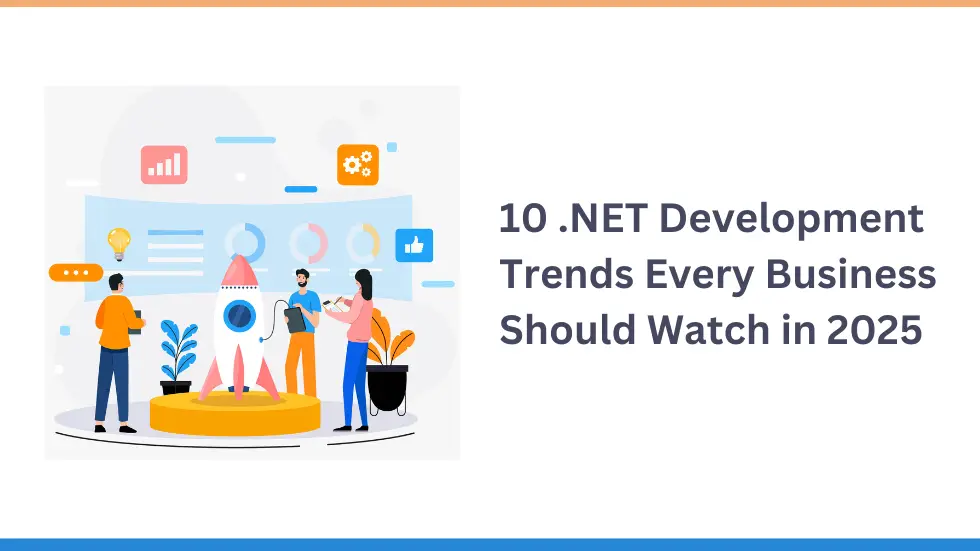The .NET ecosystem has become one of the most powerful frameworks for building enterprise applications, startup solutions, and innovative digital products.
Backed by Microsoft and an active open-source community, .NET continues to evolve rapidly, ensuring developers can deliver secure, scalable, and intelligent applications.
As technology advances, staying updated with the latest .NET development trends is critical for enterprises and startups looking to remain competitive in 2025.
From AI-driven solutions to cross-platform development and cloud-native architectures, these trends are shaping the future of .NET development.
In this blog, we explore the 10 most important .NET development trends to help your business navigate the evolving landscape.
1. ML.NET: Making Machine Learning Accessible
Machine learning is no longer reserved for data scientists. With ML.NET, Microsoft’s open-source ML framework, developers can easily integrate AI-driven features into their applications.
This trend is enabling enterprises and startups alike to build intelligent solutions with minimal expertise in machine learning.
2. .NET MAUI: A Unified Approach to Cross-Platform Development
The .NET Multi-platform App UI (MAUI) framework allows developers to build applications for Windows, Android, iOS, and macOS using a single codebase. In 2025, this will be one of the key .NET development trends, helping businesses reduce costs and accelerate delivery timelines while maintaining a consistent user experience across devices.
3. Blazor’s Growing Popularity in Web Development
Blazor, a framework based on WebAssembly, is gaining traction for building interactive and scalable web applications using C#. With enhanced server-side rendering and stronger integration with the .NET ecosystem, Blazor is fast becoming a go-to solution for businesses focused on modern web development.
4. Cloud-Native Development with Azure
Enterprises are embracing cloud-native architectures, and Azure continues to lead the way for .NET applications. With services like Azure Functions, App Services, and Kubernetes (AKS), developers can build scalable, serverless solutions. This makes cloud-native development one of the most impactful .NET development trends for enterprises in 2025.
5. Performance and Scalability in .NET 8
Performance is at the core of modern applications. Microsoft’s release of .NET 8 brings improvements in runtime performance, memory efficiency, and scalability. Businesses can leverage these enhancements to handle enterprise-level workloads and deliver smoother customer experiences.
6. Enhanced Security for Modern Applications
In today’s digital-first world, application security is non-negotiable. .NET continues to strengthen its security features with better vulnerability scanning, authentication, and encryption tools. In 2025, one of the most vital .NET development trends will be a sharper focus on security-first application design.
7. Microservices and Containerization with .NET
The demand for microservices architecture and containerization continues to rise. Using Docker with .NET Core, businesses can create modular applications that are scalable, resilient, and easier to manage. This trend is especially relevant for enterprises adopting agile, cloud-native strategies.
8. AI and Bot Integration in .NET Applications
From virtual assistants to automated workflows, AI and bot development are redefining enterprise applications. With .NET’s growing support for AI frameworks and APIs, businesses can embed intelligence into applications, improving decision-making, customer support, and productivity.
9. Improved Developer Experience
Microsoft has been consistently investing in improving the developer experience (DX) for .NET. From Visual Studio enhancements to streamlined debugging and better learning resources, the focus is on making .NET development more efficient and beginner-friendly. This ensures faster onboarding and productivity across enterprise teams.
10. Open-Source Community Contributions
Open-source innovation is one of the strongest drivers of growth in the .NET ecosystem. The community’s contributions to frameworks, libraries, and tools will continue to expand in 2025, offering developers more opportunities to collaborate and innovate.
Why Staying Updated on .NET Development Trends Matters
The future of .NET development is bright, with new tools, frameworks, and best practices emerging rapidly. For enterprises, startups, and seed-funded companies, staying ahead of these .NET development trends ensures your applications remain secure, scalable, and aligned with market demands.
By embracing the latest .NET technologies, your business can deliver future-ready solutions that stand out in a competitive digital landscape.
Additional Resources:
